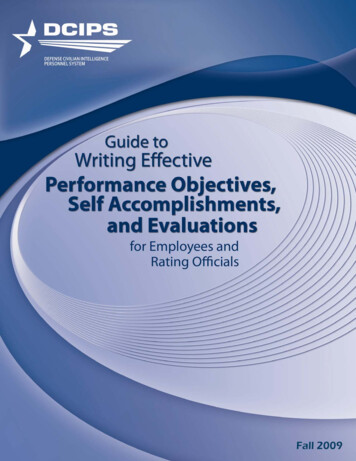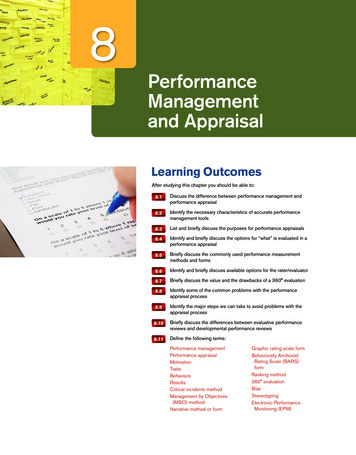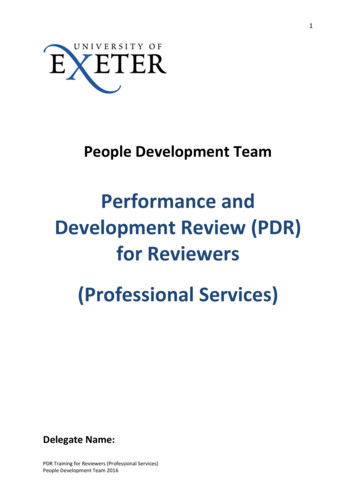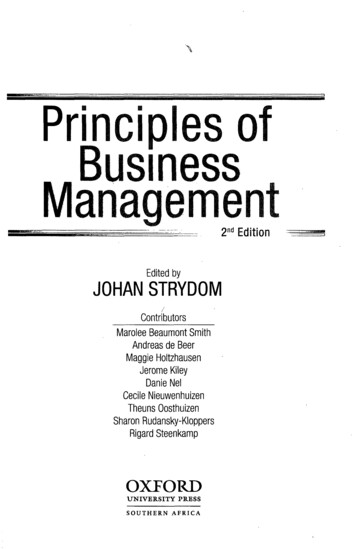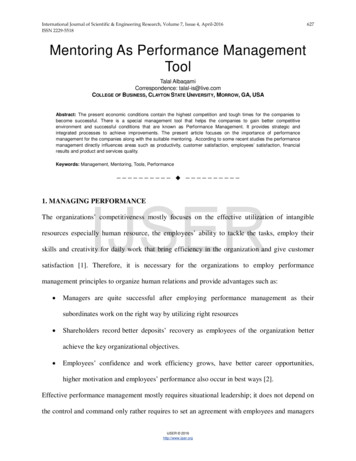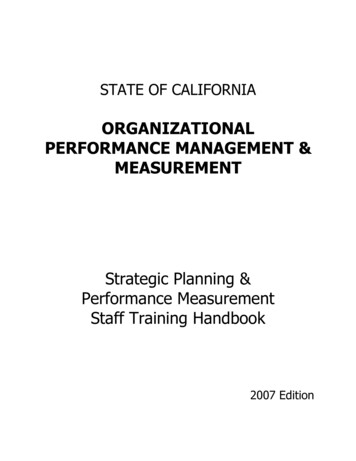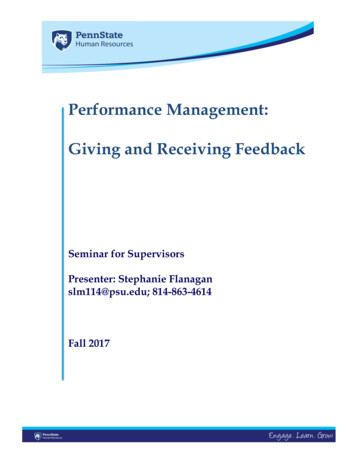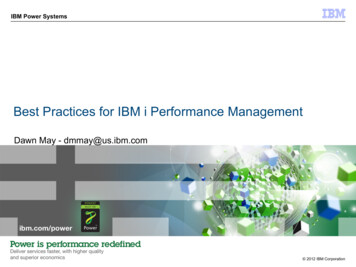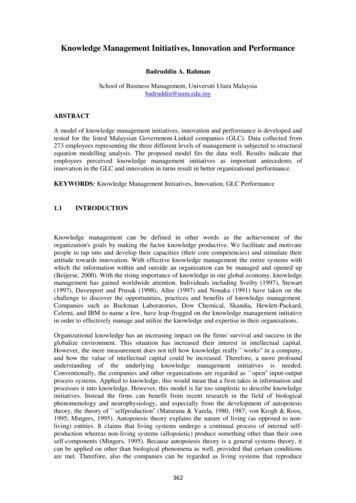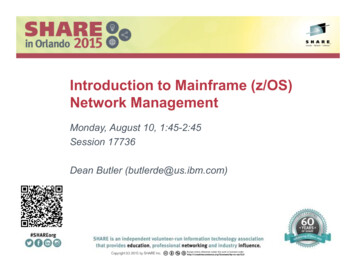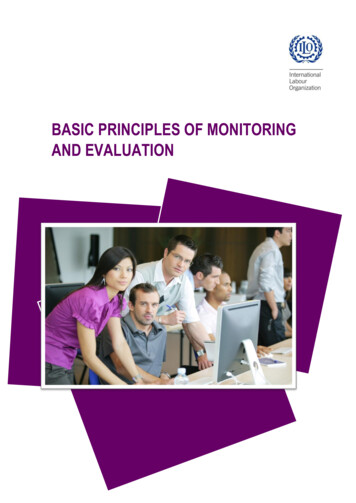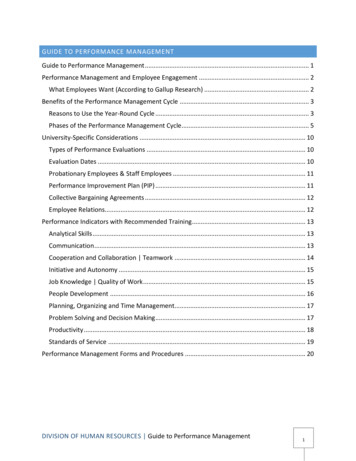
Transcription
GUIDE TO PERFORMANCE MANAGEMENTGuide to Performance Management . 1Performance Management and Employee Engagement . 2What Employees Want (According to Gallup Research) . 2Benefits of the Performance Management Cycle . 3Reasons to Use the Year-Round Cycle . 3Phases of the Performance Management Cycle. 5University-Specific Considerations . 10Types of Performance Evaluations . 10Evaluation Dates . 10Probationary Employees & Staff Employees . 11Performance Improvement Plan (PIP) . 11Collective Bargaining Agreements . 12Employee Relations. 12Performance Indicators with Recommended Training. 13Analytical Skills . 13Communication . 13Cooperation and Collaboration Teamwork . 14Initiative and Autonomy . 15Job Knowledge Quality of Work . 15People Development . 16Planning, Organizing and Time Management. 17Problem Solving and Decision Making . 17Productivity . 18Standards of Service . 19Performance Management Forms and Procedures . 20DIVISION OF HUMAN RESOURCES Guide to Performance Management1
PERFORMANCE MANAGEMENT AND EMPLOYEE ENGAGEMENTImagine joining a new fitness club. While having a good run on the treadmill, you decide tocheck your stats. How fast are you going? How many calories have you burned? Do you needto speed up or slow down? You look to the screen only to find that there is no data. Today, it isalmost unimaginable that we would not be able to get instant feedback on practicallyeverything we do. Yet, this is what happens often in the workplace when performancemanagement feedback is not provided on a regular basis. Imagine if the fitnessclub made you wait an entire year to see all of your treadmill results at once!Similarly, performance management needs to include regular conversationsthroughout the year so an employee can know what is happening with theirperformance in ample time to make necessary adjustments.WHAT EMPLOYEES WANT (ACCORDING TO GALLUP RESEARCH)Through research efforts to discover what motivates employeeengagement, the Gallup organization identified the following 12factors. According to these findings, most professionals want:1. To know what’s expected of them2. To have the tools they need to do their work3. To have the opportunity to do what they do best every day4. To receive recognition and praise for doing good work5. To be seen and valued as people (not just job functions)6. To have someone encourage their development7. To have their opinions count8. To feel that what they do is important and worthwhile9. To have coworkers who are committed to quality work10. To have positive work relationships11. To talk about their progress and receive feedback12. To have opportunities to learn and developAt least half of these can be directly achieved through the performance planning andcommunication process.DIVISION OF HUMAN RESOURCES Guide to Performance Management2
BENEFITS OF THE PERFORMANCE MANAGEMENT CYCLEPerformance management is a cycle through which supervisors and those they lead gain ashared understanding of work expectations and goals, exchange feedback, identify learning anddevelopment opportunities, and evaluate performance AlignmentwithMission &VisionDailyCoaching &FeedbackQuarterlyPerformanceCheck-InThe steps of the performance management cycle should always revolve around the mission andvision of the University. The cycle includes performance planning for the year ahead, dailycoaching and feedback, quarterly performance check-ins and the formal performance review.Before we break down these steps, realize that utilizing the entire cycle can make the formalannual review meeting less stressful. Here are several reasons why the year-round cycle is soimportant.REASONS TO USE THE YEAR-ROUND CYCLENo Surprises: Because conversations will have been ongoing, nothing should be a surprise toeither the employee or supervisor at the time of the performance evaluation.Shared Understanding of What Success Looks Like: If expectations are clarified ahead of time,both the employee and supervisor will have time to address questions and seek furtherguidance. Discussions throughout the year might include a defined set of ratings with examplesfor each category. When requirements are shared ahead of time, an employee knows exactlywhat to do to meet the "achieves, exemplary or commendable" ratings. Likewise, an employeewill have an idea of what actions or inactions might be met with an “unsatisfactory” or "needsDIVISION OF HUMAN RESOURCES Guide to Performance Management3
improvement" rating. The Division of Human Resources (DHR) provides performance ratingguides for both the staff and administration performance evaluation forms that are available atany time. These rating guides serve as rubrics to follow.Opportunity for Growth: Waiting until the end of the year to do a "performance review" doesnot provide the employee a chance to grow and make corrections before it is too late. Periodiccheck-ins allow the opportunity to see if there are any knowledge or skills gaps. For manydifferent reasons, an employee may not have the adequate knowledge or skills to besuccessful. Knowledge, skills and competencies can be assessed throughout the year so thattraining and coaching may be provided for the employee's development. The back of this guidecontains a list of Performance Indicators with Recommended Trainings.Focus on the Future: Performance management is not just about the past. It provides theconduit to move forward by identifying opportunity for growth and goal-setting for theupcoming year.Taking notes throughout the year: Helps when looking for trends over timeReduces biases such as:o Primacy Bias or Recency Bias - when we remember the earliest or latestmoments in greatest detail.o Horns or Halo Bias - makes it harder to be objective the more we like or dislike aperson.Provides backup if action is neededProvides a reference throughout the annual review meetingDIVISION OF HUMAN RESOURCES Guide to Performance Management4
PHASES OF THE PERFORMANCE MANAGEMENT CYCLE1. PERFORMANCE PLANNING FOR THE YEAR AHEADClarify the expectations and standards for the job. This is when the performance goals for theyear will be set. What will the employee strive to achieve in the coming year?Development goals will need to be set as well. What knowledge/skills will the employee work todevelop or enhance in the coming year?Before these goals can be set, consider USF’s mission, vision and strategic plan. Additionally,careful review should be given to the employee’s position description to make sure that thegoals fall within what is written. Consider what is expected of someone in the specific role andwhat standards must be maintained.Alignment with Organizational Mission & Vision: Effective performance goals flow from andsupport the mission, vision, and goals of the team, department, and University. By ensuringthat the mission, goals and strategies of the larger organizational unit drive all performancemeasures and improvement initiatives, supervisors are better able to help employees see howtheir efforts contribute to the achievements of the team, department and University.IndividualGoalsDepartment & TeamGoalsUSF StrategiesUSF Mission, Vision & ValuesDIVISION OF HUMAN RESOURCES Guide to Performance Management5
USF's Strategic Plan: Employees at USF should be familiar with the Strategic Planand understand how their role supports and contributes to the University's vision, mission,values, and goals. These items are listed and linked on the performance evaluationforms. However, employees and supervisors should review the information well in advance toensure that employee and departmental goals strategically align.View USF's Strategic Plan, Mission, Vision and Values.Assignments and Position Descriptions: The employee and supervisor need to have a sharedunderstanding of how well the employee is doing. For this, duties and responsibilities must beclarified to provide a framework. The first step in clarifying understanding of the job is to makesure the position description is accurate and up to date. The employee should see a copy of theposition description and have an opportunity to ask any questions. Keep in mind that the samejob title will likely have different duties from one department to another.Clarify Expectations by Using SMART Goals: How do you know if goals are being met? Setspecific achievement markers by using SMART goals. Access a one page example here or viewthe online LinkedIn Learning training, Setting Team and Employee Goals. (Total run time: 1hour 9 minutes)"Employee goals should be driven by the organization's needs—whether it's to cut costs, driverevenue, or build skills - and keep employees motivated to succeed. Mike Figliuolo, managingdirector of thought LEADERS and former McKinsey consultant, helps you set employee goalsthat are SMART: specific, measurable, achievable, relevant, and time-bound. Using the SMARTframework, he shows you how to develop goals that are achievable and appropriate to youremployees' roles.” - DESCRIPTION FROM LINKEDIN LEARNINGClick here for LinkedIn Learning login instructions.(LinkedIn Learning is formerly Lynda.com)DIVISION OF HUMAN RESOURCES Guide to Performance Management6
2. DAILY COACHING & FEEDBACKDiscuss performance often. Effective coaching occurs throughconversations. These conversations occur regularly, rather thanbeing reserved for formal reviews. Share feedback about theemployee's successes and areas needing improvement. Discusstraining needs as they arise. The conversation should be back andforth; seek employee input about the work process and results.Keep conversations balanced to address strengths as well asconcerns. For example: How is the employee doing?Does the employee need help or motivation?Is there something done well that can be recognized?THEACTION-IMPACT FORMATConversation stepswhen addressingperformance concernsor problems: State the action(behavior) youobserved.Provide appreciative feedback and recognize successes. Payattention between conversations to catch people in the act of doinggreat work. Thank people in person and attach praise to meaningfulresults. Instead of just “good job,” try, “The solution you offeredhelped us to avoid a potential problem and exceeded the client’sexpectation.” Describe the impactthe action had onresults.Address concerns and solve problems. Be timely and addressconcerns as the needs arise, but only address a manageable numberof concerns at one time. When addressing problems with theemployee’s performance: Listen non-defensivelyand seek tounderstand the other’sperspective. Be specific and give examplesFocus on observable actions and their impactFocus on problem resolution rather than blameCollaborate to accurately define the problem and brainstormsolutionsPresent your view of the problem. If the problem is a concernyou have about the employee’s actions, use the ActionImpact format (see sidebar) to present your concern. Invite and hear theother’s view of theproblem. Identify a definition ofthe problem that isagreeable to both ofyou. Brainstorm possiblesolutions. Agree on a strategy toimplement. Schedule a follow-upmeeting to check thesuccess of thestrategy.DIVISION OF HUMAN RESOURCES Guide to Performance Management7
3. QUARTERLY PERFORMANCE CHECK-INThe quarterly check-in is a “progress check” conversation atleast once per quarter to review goals, progress and results. It istime to acknowledge successes and identify improvementopportunities. The following should be considered in thequarterly check-in: Is the employee meeting expectations and standards?Is the employee achieving performance goals?Is the employee achieving developmental goals?If any areas cause concern, make mid-course adjustments where needed and review or clarifyany standards not being met. What changes would enhance performance or progress toward the goal?Are expectations still clear?The quarterly check-in should be scheduled ahead of time, allowing both the employee andsupervisor time to gather all necessary information. DHR provides an optional QuarterlyPerformance Check-In Form. It may be helpful to have the employee complete such a formbefore the meeting.4. FORMAL PERFORMANCE REVIEWMeet annually to review and document feedback from the previous year. Were performancegoals achieved? Were professional development goals achieved? This meeting also segues intoperformance planning for the next year.During annual performance reviews, supervisors and employees work together to: Review the employee’s work achievements and challenges over the past year.Establish work expectations and performance goals for the coming year.Define the employee’s professional development goals and learning plan for thecoming year.The forms utilized in this process will assist supervisors and employees in preparing forperformance review discussions. Although these forms are helpful and necessary tools, thefilling out of forms is not the primary goal of a review. Reviews are most effective when formsare used to help prepare for a conversation and document the outcomes, rather than as asubstitute for the conversation.DIVISION OF HUMAN RESOURCES Guide to Performance Management8
Preparing for the Formal Review Review the following: The employee’s position description (PD) Standards and expectations Past year’s goals and objectives Other documentation gathered during the review period Request the employee complete the Performance SelfAssessment and ask the employee to prepare by reflecting onthe following: Successes and challenges over the past year Additional support he or she would like from you Additional skills/knowledge he or she would like todevelop or enhance Complete either the Staff Performance Evaluation Form orthe Administration Performance Evaluation Form. Beprepared to share your perceptions and feedback about theemployee’s performance over the past year, including: Key achievements and successes Performance concerns and/or challenges Changes and enhancements that you recommend (orrequire) Learning opportunities relevant to the employee’s jobfunction that would help enhance current skills or developnew ones Key employee strengths and contributions over the pastreview periodBEST PRACTICES Schedule evaluationmeetings in advance. Use a private,interruption-freesetting. Allow sufficient time fordiscussion. Consider in advancehow to presentinformation. Set tone for respectful,adult-to-adultinteraction. Start and end onpositive note.The Performance Rating Guides for both Staff and Administrationfound on the Division of Human Resources website are extremelyhelpful with providing consistent, more accurate ratings andcomments.Conducting the ReviewShare your feedback about the employee’s performance, includinginformation about strengths and successes as well as areas needingimprovement.Communicate the rating you’ve assigned for each of the performanceindicators. Provide rationale for each rating - include behavioralexamples whenever a rating is above or below “achieves.”DIVISION OF HUMAN RESOURCES Guide to Performance Management9
Invite and listen to the employee’s assessment of his/her performance. Ask the employee toshare his/her feedback for you, including ideas for improvement.Re-enter the performance planning phase for the following year.UNIVERSITY-SPECIFIC CONSIDERATIONSThe items in this section are specific to the University of South Florida. It is important to payspecial attention to these.TYPES OF PERFORMANCE EVALUATIONSUSF has three types of performance RYThe probationary period allows the employee to learn the job and the supervisor to observeprogress. The probationary evaluation must be completed within the 30-day period BEFORE theprobationary end date. First-time staff employees serve an initial 6-month probation beforegaining regular status, while new law enforcement employees serve a 12-month probation.This also applies to Staff employees serving a probationary period in a new job class.IF the probationary evaluation is NOT done before the end date, the overall performance ratingwill default to “Achieves” and the employee will gain regular status.For more information about probationary employees procedures, visit the ProbationaryEmployees web page.ANNUALAll Staff and Administration employees on a position are to be evaluated annually. The reviewsare due within 30 days following the annual evaluation date.EVALUATION DATESDates of annual performance reviews differ by department. Some departments choose toconduct reviews by the fiscal year, while others abide by anniversary dates. Several areas havedesignated annual common performance evaluation dates. Check with your department tosee what date or timing system is used.DIVISION OF HUMAN RESOURCES Guide to Performance Management10
SPECIALA special evaluation may be completed for several reasons such as: At any time the supervisor determines the employee's overall performance haschanged from the level reflected on the most recent evaluation. During the initial probationary period to address substandard performance. In response to a written request for a performance evaluation, provided theemployee has not received an evaluation in six months and has not received anevaluation with an overall substandard rating. For other reasons, such as when the employee or employee’s supervisor leaves aposition.STAFF EMPLOYEESStaff employees have relevant information that can be found in the Staff PerformanceManagement Procedure and in the Staff Progressive Discipline Procedure. If you havesupervisory duties, you are encouraged to thoroughly review the Staff Progressive DisciplineProcedure.PERFORMANCE IMPROVEMENT PLAN (PIP)A Performance Improvement Plan (“PIP”) will need to be developed following a substandardStaff performance evaluation. At this point, the Supervisor should contact his/her ServiceCenter HR Manager at the Division of Human Resources or regional HR Office for assistance toensure required communications to the employee are sent.The PIP lays out the standards and expectations based on the duties, responsibilities, andrequirements of the position that must be met to obtain an overall "Achieves" rating. Theminimum duration of a PIP is 60 calendar days; the PIP can be extended to a maximum durationof 6 months. Additionally, supervisors are required to meet weekly or bi-weekly with theemployee to discuss progress. Written updates from these meetings must be sent to theService Center HR Manager.At the end of the PIP period, a follow-up Special Evaluation is completed and: Rating revised upwards orExtension of improvement period requested orIf no improvement, the employee can be demoted to another job orThe employee's dismissal can be proposed.See the PIP form here.DIVISION OF HUMAN RESOURCES Guide to Performance Management11
DO ADMINISTRATION EMPLOYEES RECEIVE PIPS?No. Instead, Administration employees receive an action plan for improving performance andONE performance evaluation either at start or end of improvement period.COLLECTIVE BARGAINING AGREEMENTSCollective Bargaining Agreements (CBAs) should be thoroughly considered during theperformance management process. For example, a CBA may make provisions for an employeewho does not meet performance standards. Each union has their own agreement; review themost up-to-date agreements online via the Division of Human Resources - Collective Bargainingand Labor Relations site.EMPLOYEE RELATIONSEmployee Relations (ER) provides education, training,mentoring and guidance to individual employees, supervisors,managers and administrators to address questions andworkplace issues for non-faculty employees.Service Center HR Managers work with departmentadministrators and individual employees on effective employeemanager communications and provide individual coaching toimprove employee performance and resolve conflicts and problems before the point of formalcorrective action and grievance.Service Center HR Managers advise on and interpret University policies, procedures,regulations, labor contracts, key state statutes and federal laws, and oversee the Universitylayoff, progressive discipline, performance improvement plan, and non-reappointmentprocesses.Employee Relations services include: Performance managementComplaint resolution and conflict mediationCounseling and formal disciplineCollective bargaining agreement complianceGrievance proceduresApplicable alcohol/drug testing (pre-employment and regulatory)View the Employee Relations Contact for your HR Service Center.DIVISION OF HUMAN RESOURCES Guide to Performance Management12
PERFORMANCE INDICATORS WITH RECOMMENDED TRAININGThe following performance indicators are those that employees will berated on within the performance evaluation. The recommendedtrainings that follow are a starting point for employees who may needscaffolding in these areas.Many of the recommended trainings on this page are provided byLinkedIn Learning (free to USF employees). Click herefor login instructions.ANALYTICAL SKILLSUses a variety of techniques to analyze situations most efficiently; assesses riskor return on investment and makes appropriate decisions.RECOMMENDED TRAINING FOR ANALYTICAL SKILLSCritical Thinking (1 hour 6 minutes)"Critical thinking is the ability to think reflectively and independently in order to makethoughtful decisions. By focusing on root-cause issues, critical thinking helps you avoidfuture problems that can result from your actions. In this course, leadership trainer andexpert Mike Figliuolo outlines a series of techniques to help you develop your criticalthinking skills. He reveals how to define the problem you're trying to solve and thenprovides a number of critical thinking tools, such as blowing up the business, asking the 5whys, asking the 7 so whats, using the 80/20 rule, and more. He also provides guidance onhow to develop this skill across your whole team." - DESCRIPTION FROM LINKEDINLEARNINGClick here to access Critical Thinking in LinkedIn Learning.COMMUNICATIONShares information effectively in verbal and written form with variousaudiences (including ability to deliver presentations in a professional,organized, and persuasive manner); listens attentively and openly to the ideas,concerns, and suggestions of others. Communications: Shares informationeffectively both verbally and in writing (including formal presentations) with various typesof audiences; listens attentively and openly to the ideas, concerns, and suggestions ofothers.DIVISION OF HUMAN RESOURCES Guide to Performance Management13
RECOMMENDED TRAINING FOR COMMUNICATIONCommunication Foundations (1 hr 24 min)"Learn how to communicate more effectively. Your communication skills affect your careerprospects, the value you bring to your company, and the likelihood of your promotion. Thiscourse helps you communicate better in a variety of professional situations, includingmeetings, email messages, pitches, and presentations. Instructors Tatiana Kolovou andBrenda Bailey-Hughes introduce the four building blocks of communication—people,message, context, and listening—and show how they apply in different circumstances.Through the use of vignettes and applied tools, the course shows how to build this corecompetency and communicate in a way that effectively and professionally conveys yourmessage." - DESCRIPTION FROM LINKEDIN LEARNINGClick here to access Communication Foundations in LinkedIn Learning.Communicating with Diplomacy and Tact (1 hour 5 minutes)"Diplomacy is a mindset; tact is a strategy. In this course, communications professor TatianaKolovou helps you realize the benefits of communicating with tact and diplomacy inworkplace situations. She walks you through four scenarios that you might encounter on anaverage day, and coaches you through appropriate responses to challenging situations atwork. She emphasizes core skills, such as authenticity, empathy, and listening, and showsexamples, stories, and facts that bring their importance to life. By taking opportunities topractice at work and in your personal life, you can strengthen this delicate balance of skillsand build relationships that can survive difficult interactions." - DESCRIPTION FROMLINKEDIN LEARNINGClick here to access Communicating with Diplomacy and Tact in LinkedIn Learning.DHR's Learning and Talent Development Department offers an EffectiveCommunication Certificate Series. Participants must complete 5 online courses within oneyear. For more information, visit the Effective Communication Series webpage.COOPERATION AND COLLABORATION TEAMWORKDIVISION OF HUMAN RESOURCES Guide to Performance Management14
Cooperation and Collaboration: Builds strong working relationships withcolleagues throughout the organizational unit and the University and seeksopportunities to partner with others to achieve goals and objectives.Teamwork: Participates in achieving organizational unit goals and objectives and workseffectively with other colleagues at the University.RECOMMENDED TRAINING FOR COOPERATION AND COLLABORATIONBeing an Effective Team Member (31 minutes)"It's easy to call out the qualities that make someone a poor team member. But what makesa person invaluable on a team? In this course, Kelley School of Business professor Dr. DaisyLovelace highlights the key characteristics of exemplary team members. As she dives intoeach trait, Daisy shares how—by making subtle changes—you can adopt these behaviors tobecome a more valuable collaborator. Learn tips that can help you increase your selfawareness, demonstrate that you're a reliable teammate, approach teamwork morecollaboratively, and more." - DESCRIPTION FROM LINKEDIN LEARNINGClick here to access Being an Effective Team Member in LinkedIn Learning.INITIATIVE AND AUTONOMYAccepts and carries out current and new responsibilities throughresourcefulness and self-reliance.RECOMMENDED TRAINING FOR INITIATIVE AND AUTONOMYDeveloping Resourcefulness (29 minutes)Being able to do more with less is a highly valued skill in any organization, and not just indown times. In this course, management expert and trainer Todd Dewett helps you assessyour resourcefulness by first evaluating your professional resources (personal network,expertise, information, and access to finances) and how to decide when and how to usethem. He also provides advice on developing habits to cultivate resourcefulness, such asasking the right questions and building your network across a broad spectrum.- DESCRIPTION FROM LINKEDIN LEARNINGClick here to access Developing Resourcefulness in LinkedIn Learning.JOB KNOWLEDGE QUALITY OF WORKDIVISION OF HUMAN RESOURCES Guide to Performance Management15
Job Knowledge: Demonstrates the technical, managerial, and organizationalknowledge to successfully execute duties; shows knowledge andunderstanding of higher education and of the profession.Job Knowledge: Demonstrates sufficient knowledge, competency, and understanding toperform all aspects of the job efficiently, effectively, and safely.Quality of Work: Produces work that is comprehensive in scope, complete in detail, andaccurate in contentRECOMMENDATIONS TO INCREASE JOB KNOWLEDGECareerOneStop is sponsored by the U.S. Department of Labor, Employment and TrainingAdministration. Because requirements for job knowledge vary greatly, CareerOneStop is arich resource with a wide array of offerings. Enter a specific job category to find multipletraining paths and local associations that my help in professionaldevelopment. Additionally, explore the many learning resources within USF that
DIVISION OF HUMAN RESOURCES Guide to Performance Management 3 BENEFITS OF THE PERFORMANCE MANAGEMENT CYCLE Performance management is a cycle through which supervisors and those they lead gain a shared understanding of work expectations and goals, exchange feedback, identi
